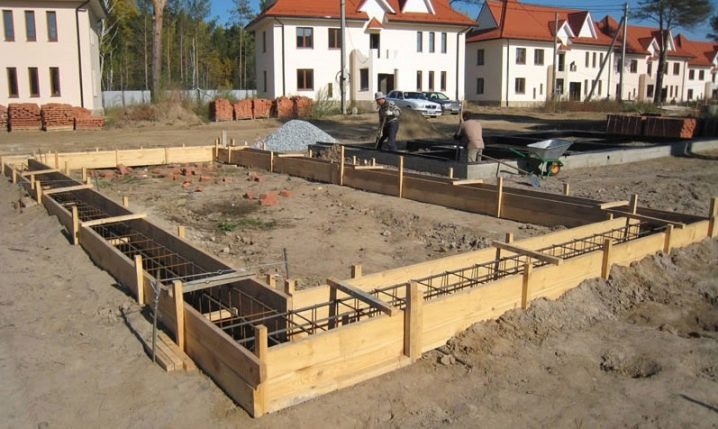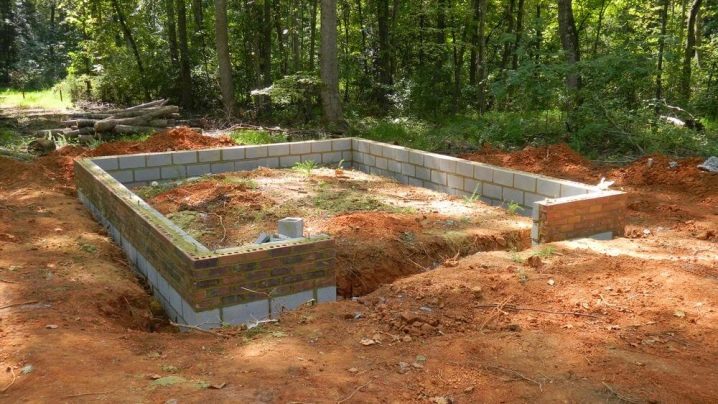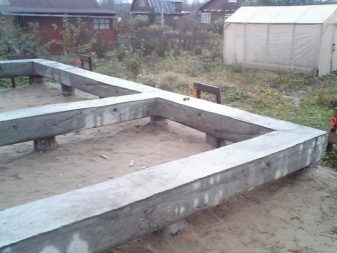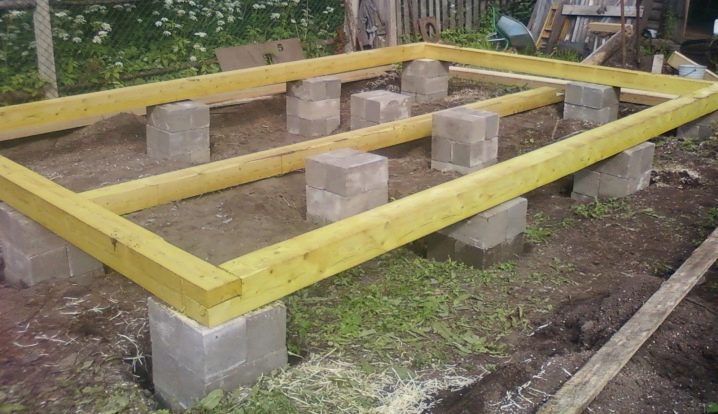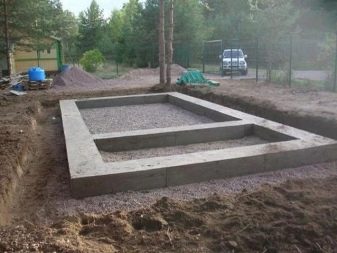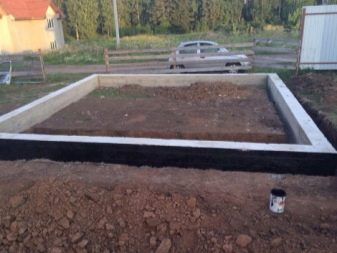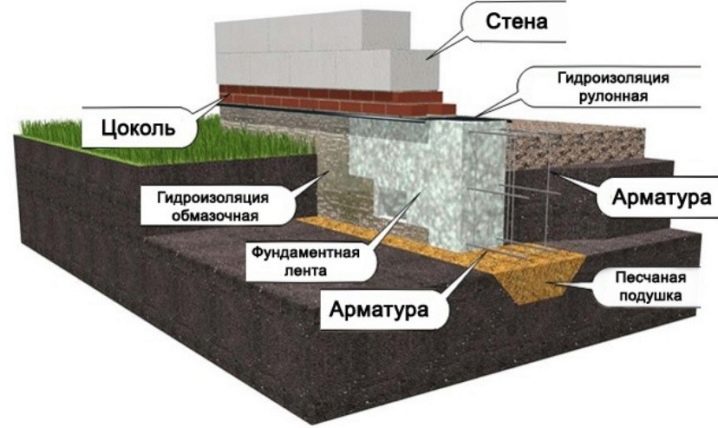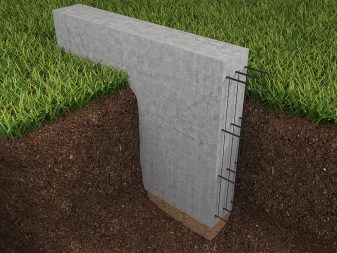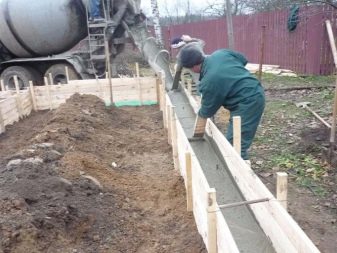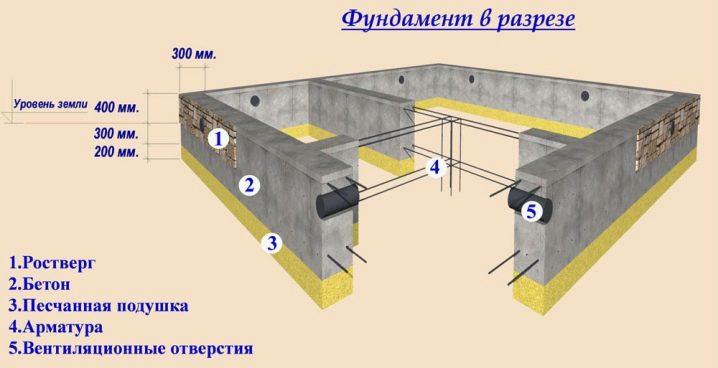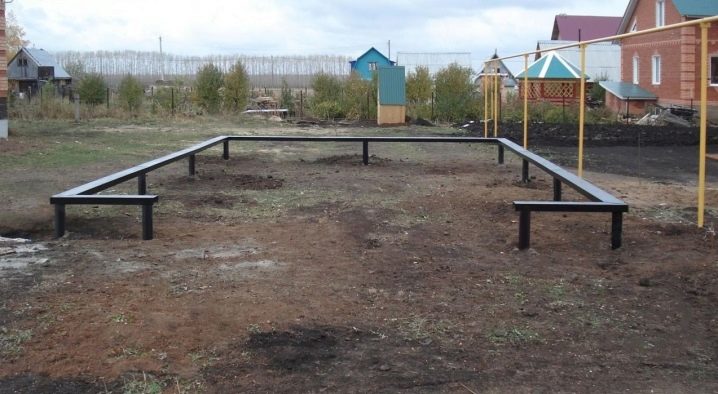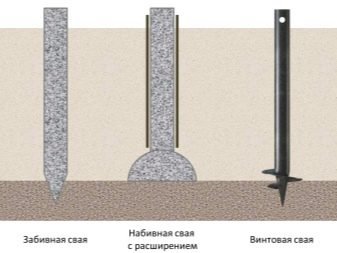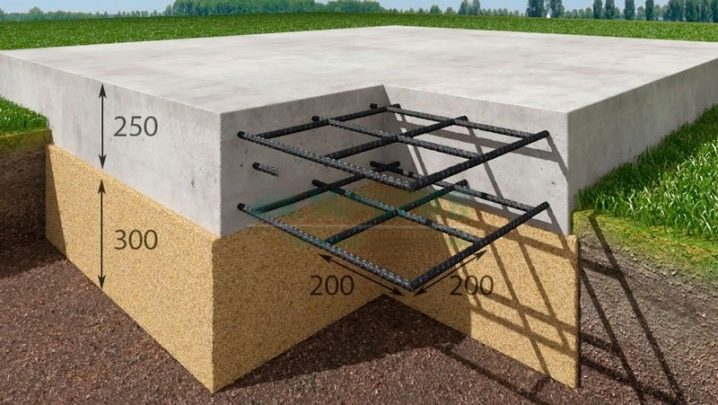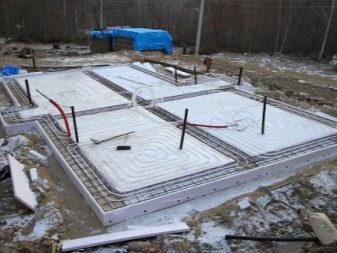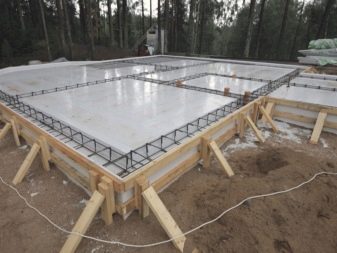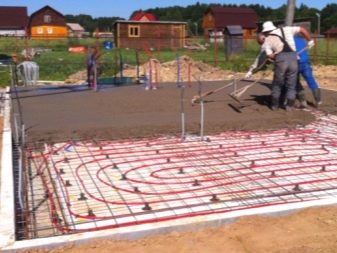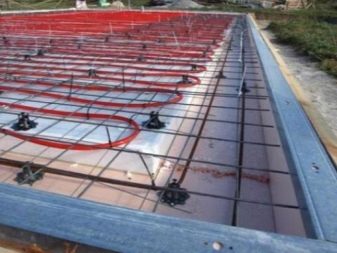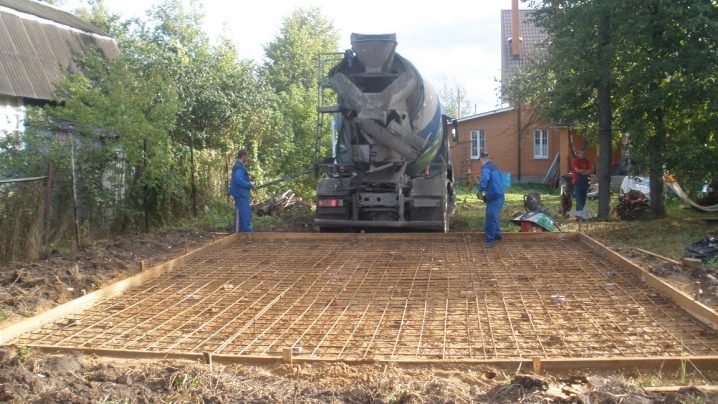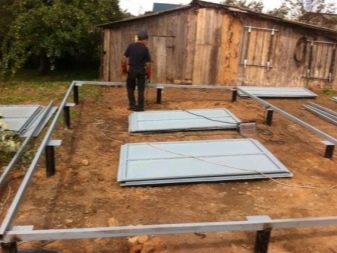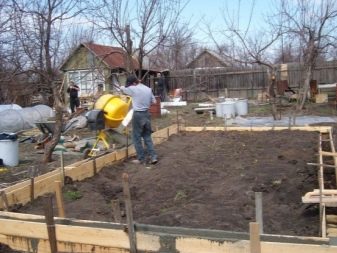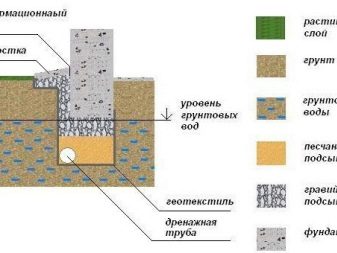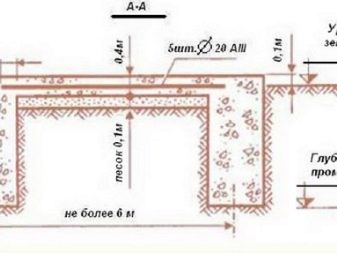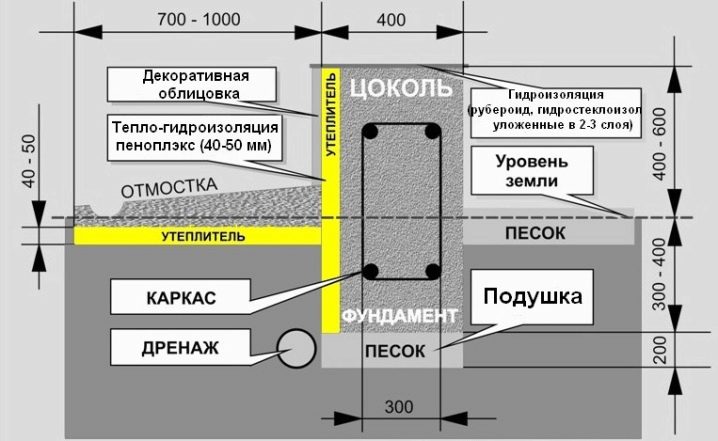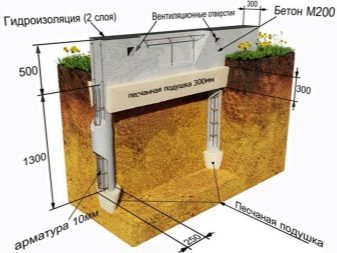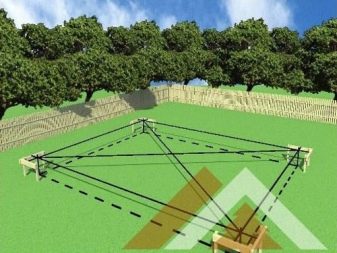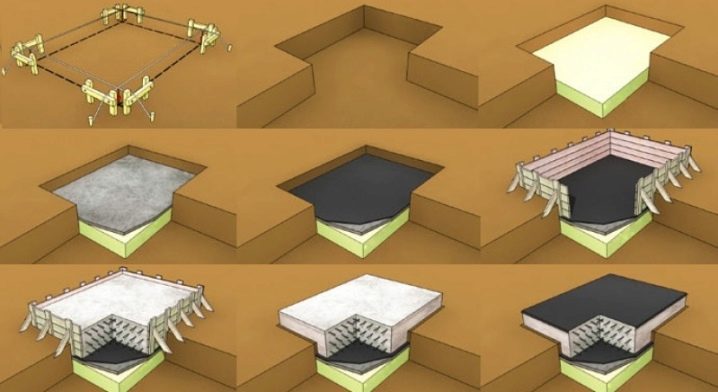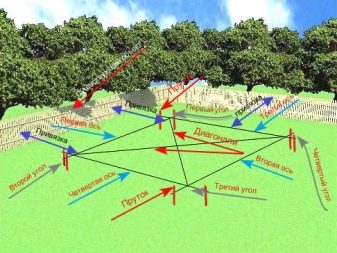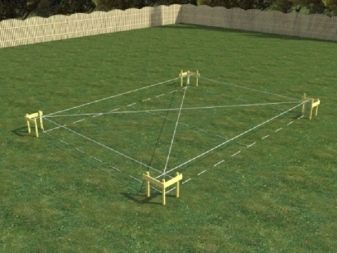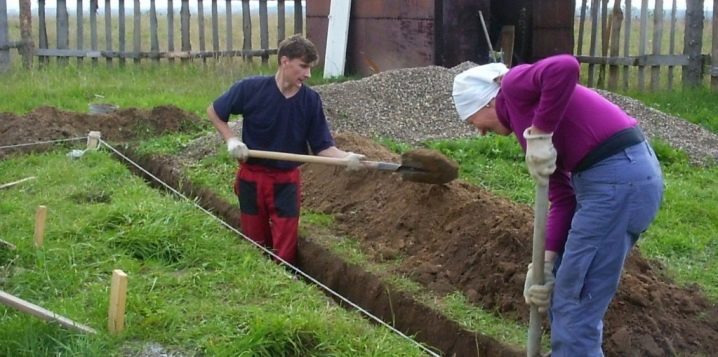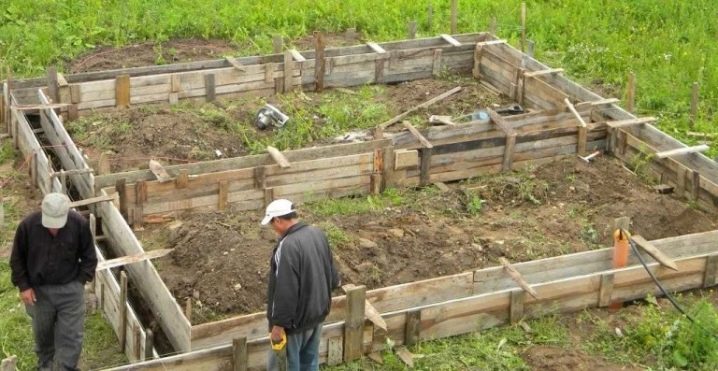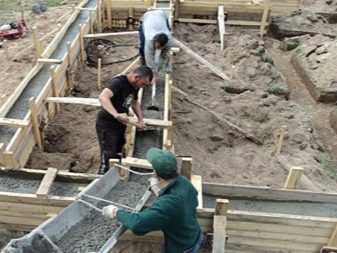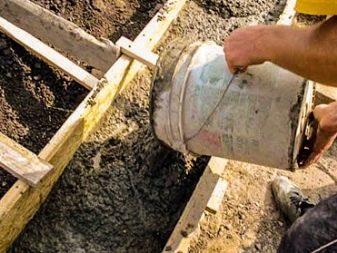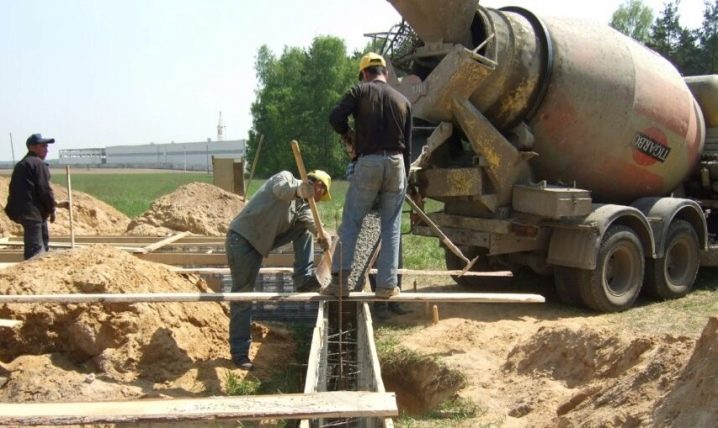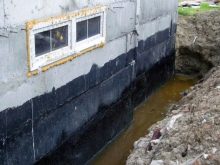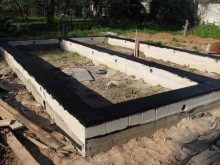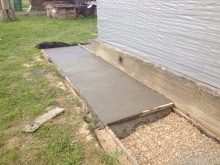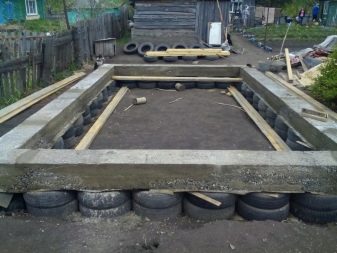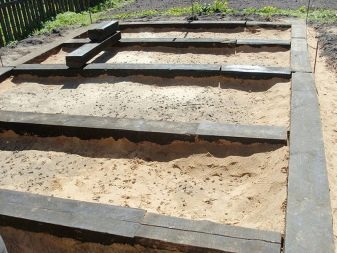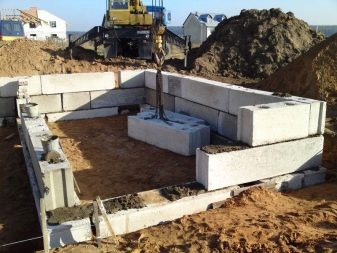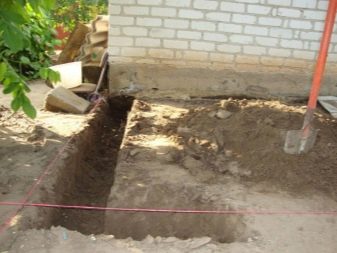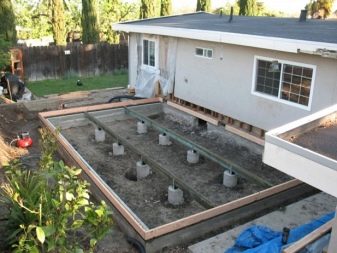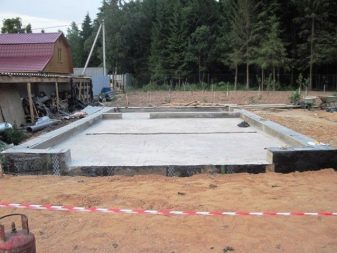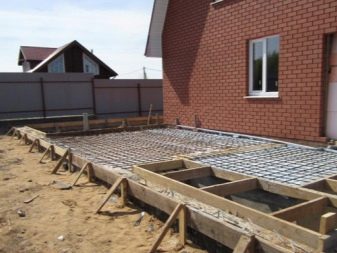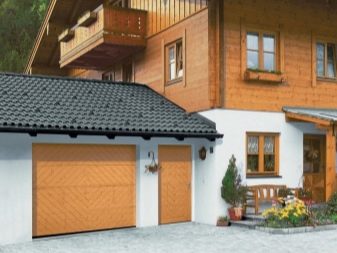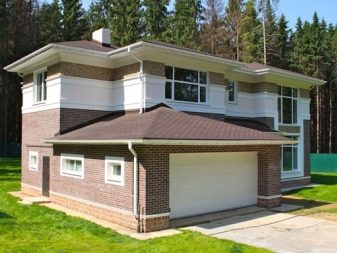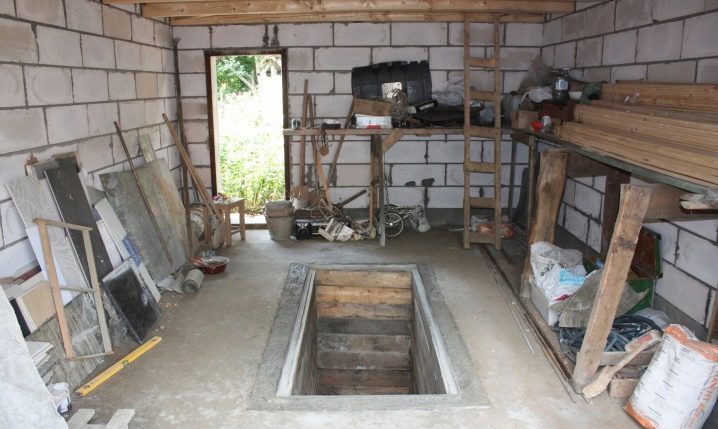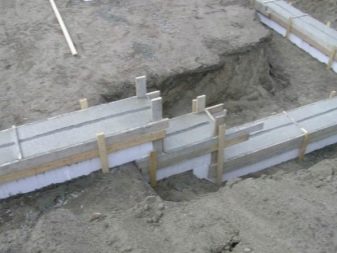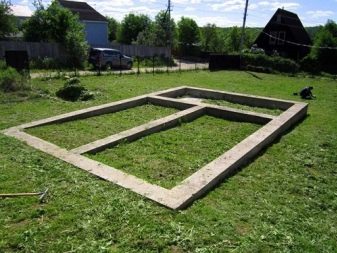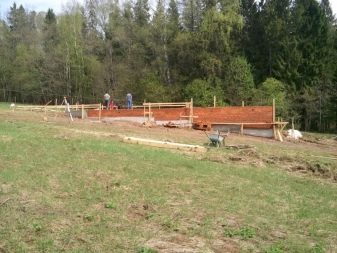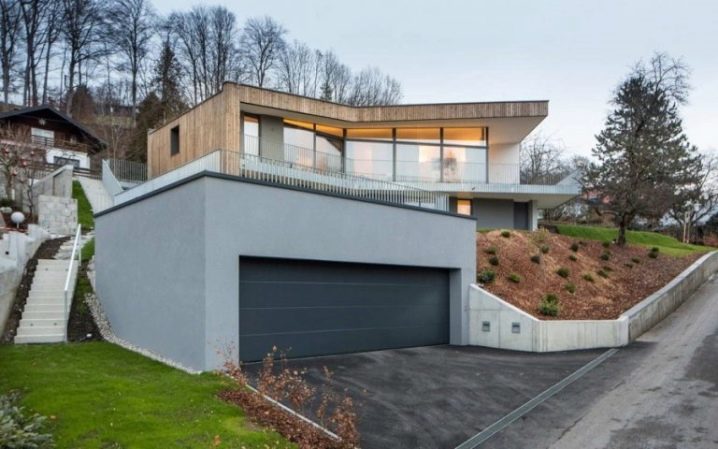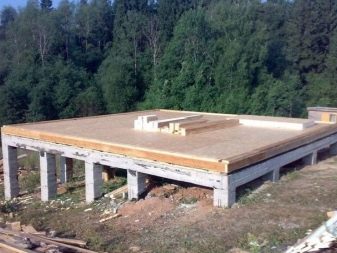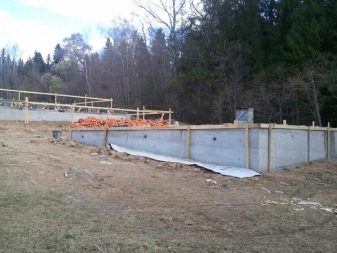Making the foundation for the garage with your own hands
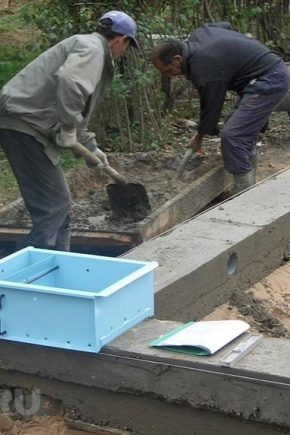
The construction of a garage, like any other structure, begins with the creation of the foundation - the foundation. A reliable foundation will provide the “home” for your car as long as possible.
Species
In the construction of several common types of foundations. They differ in the following parameters:
- according to the method of bearing on the soil and configuration;
- on materials from which the foundation is laid.
Consider the four main categories of foundations.
Columnar
The design of such a base is a pillar of stone, buta (drake stone) or brick. The supports are constructed in steps of approximately 1.2 to 2.5 meters below the most important concentration points of the loads of the future structure. (intersection of walls, corners, in places of installation of heavy boiler equipment, etc.). In order to combine the individual pillars into a sturdy structure, beams are placed on top of them, which connect the head posts, and as a result a ready-made base comes out.
Separately, it should be said about the column foundation, made by TISE technology. Its principle is to drill wells at the points of installation of supports, then strengthen them with reinforcement and fill them with concrete. Another name for this base is columnar monolithic. The lower segment of the pillar (sole) has an extension.
Distinctive characteristics of the foundation:
- Can be used on light soils that are not prone to movement (displacement) and a strong increase in volume (heaving). Excellently manifested itself in deep frozen heaving soils.
- The excellent decision for construction of low constructions (bar-shaped, panel board, frame houses).
- Reasonable price, minimum cost of working time (compared to other types of grounds).
- Does not require waterproofing.
- It is used for structures without basements.
- Durable, cheap foundation, intensively practiced in private construction.
Tape
The name of the foundation is entirely consistent with the visual representation of its structure. This is a tape of reinforced concrete, stretched under all the bearing external and internal walls of the building.
The manufacture of such a framework requires the implementation of large-scale earthworks and the cost of building materials, compared with the above described analogue.
There are:
- Shallow Ribbon Foundation - suitable for light buildings of blocks, logs, frame structures. Depth location no more than 70 cm, that is, not below the boundary of soil freezing. Suitable for constant soils or heaving (dispersed), freezing soils deep.
- Recessed foundations - arranged below the freezing depth. Able to withstand heaving (increase in volume) and soil movements. Suitable for heavy brick, stone and other buildings. If the structure is built of light materials and has a small mass, then such a base is better not to do, since the weight of the structure will be very small for the stability of the base during heaving and soil movement.
- Monolithic tape - finished formwork, reinforced with reinforcement, is poured with a solution of concrete. Combined tape - the basis of large foundation blocks of reinforced concrete. Weakness: some inconveniences may appear when building a foundation with a complex configuration. The main advantages of such foundations are: operational flexibility (suitable for almost all types of soil and types of buildings), as well as the possibility of building cellars, garages and basements.
Pile
This type of base is optimal for weak soils, when it is necessary to shift the load from the construction to more solid layers. In addition, the pile foundation is intensively practiced for the construction of houses on construction sites with a slope, large irregularities. Of course, you can lift the ground and level the construction site. Still, the use of piles will be cheaper.
The structure of the foundation is separately located piles connected by a grillage (beam).
By lowering each pile to the calculated depth, you can easily get a horizontal surface of the beam for wall construction.
Types of piles:
- Zabivny. For the construction of low-rise buildings are not practiced because of economic unjustified.Special equipment is needed for piling into the ground. As a rule, they are used in the construction of industrial and civil structures.
- Bored. A hole is being drilled in the ground, which is filled with a solution of concrete. The upper bearing parts of the piles are set at a certain height and are connected by a grillage. Piles are reinforced and unreinforced.
- Screw. The piles are made of metal. At the end, immersed in the ground, special screw blades are provided. Quite widely practiced in the construction of low-rise buildings, because they provide an opportunity to quickly prepare the foundation.
Plate (Swedish plate)
Powerful and heavy foundation for the construction of buildings from blocks, logs, bricks. This type of base is also called floating, and it can be used on almost any soil (including clayey, peaty and with an increased level of heaving). The slab foundation is molded on a sand-gravel bed to the size of the structure or a little more.
When the soil moves, the base “floats”, which saves the structure from destruction.
- The shallow slab base is constructed on the soil surface (only a pad is being prepared).There is no possibility of building a basement.
- Recessed slab base. For its construction, a excavation is being dug, on the basis of which concrete is poured to produce a slab. Suitable for buildings with basement, cellar, garage. Separately, it should be said about the modern slab base - the Swedish stove or UShP (warmed Swedish stove).
Its peculiarity is the side edges and the bottom, warmed by extruded polystyrene foam, carrying out communications inside the platform, as well as the “warm floor”. UWB is a heated foundation for flooring, the foundation, the overlap of the first floor.
On this slab, you can immediately erect the walls, and upon completion of construction to put the finishing flooring.
Which to choose?
The choice of a suitable foundation is an even more responsible and important task than the construction of the garage itself (except for a pencil box type garage). Since the duration of the life of the entire structure will depend on the reliability, stability and strength of the foundation.
So what kind of base to choose for the garage? Here is a rough set of simple rules:
- If the soil is marshy and the level of groundwater is high, then it is better not to construct a basement room and a viewing pit, but to arrange the foundation either slab or on piles.
- Do you live in a permafrost zone? Then build slab or pile foundation.
- If you do not need a basement and a viewing pit, then you can arrange either a shallow-tape foundation or a slab base.
- If the site has a difficult terrain, then a pile foundation with a grillage of reinforced concrete is ideal.
- If a basement is required - only a strip foundation.
How to calculate?
Due to the fact that the capital garage can be built from slag stone, brick, gypsum block, foam block, gas concrete blocks, gas silicate blocks, foam block brick, claydite concrete blocks, and, as a rule, has small dimensions, it can be built using hand-drawn diagrams without thorough calculations . But the foundation for the garage room should certainly be calculated, since the depth of the foundation determines its durability and carrying capacity during operation.
This value depends on:
- weight of the structure;
- groundwater level;
- maximum depth to which the ground freezes through in winter.
These indicators are constantly taken into account when calculating the foundation. The main factor is the depth of freezing, as it reflects the level of expansion (heaving) of the soil. Therefore, the depth of the foundation (d) is determined by a simple formula: d = depth of soil freezing in the region + 20% (m).
At elevated levels of groundwater, the reserve can not count, but pay close attention to the waterproofing of parts of the foundation.
Be sure to take into account the additional distance for the manufacture of sand or gravel cushion - 20-30 cm.
Dimensions
To calculate the width you need to know what the walls of the garage will be built from. The thickness of the beam or foundation tape must be greater than the wall thickness by 20-30% (for a wall of 300 mm blocks along the length of all sides of the foundation, a beam is made of 360-390 mm wide).
To calculate the required height of the tape, you need to know which soils are at the bottom, what is the weight of the future construction and machinery. The base under the garage, the depth of the laying of which is revealed by the level of freezing, is considered a height of + 20-30 cm to the resulting value.For solid soils, approximately 60–80 cm (the cumulative height from the lower plane of the foundation to the top without the cushion) is taken, for heaving - 1–1.5 meters.
The length of the piles is calculated according to the principle: the level of soil freezing is + 1.5 meters, approximately 2.5-4 meter products will be required.
Perimeter needs to be thought out in advance: the minimum length of walls is 3-6 meters. The best option garage 4x7 meters - there is enough space for free dislocation of a car and movement of a person.
You can set personal dimensions: add to the length and width of the car by 1-1.5 m (or another value that is most optimal for you).
How to do it in stages with your own hands?
The most common type of foundation for the garage - tape. On his example, we will analyze the step-by-step process of building the foundation.
Markup
Marking strip foundation involves the creation of a 90 degree angle. This is done like this:
- According to the plan of the future garage, determine the location of the right front corner. We hammer the first peg. This will be the front corner of the garage.
- We measure the necessary distance from it to the second auxiliary peg and drive it in.
- Between hammered stakes we stretch the fishing line (rope).
- Now from both pegs we stretch the ropes at a right angle perpendicular to the first line. And we put the third and fourth labels (we drive in stakes).
The result is a rectangle. To check the accuracy of the markup, you can use two methods:
- Measure the rectangle diagonally. They should be equal in length.
- From the corner measure a distance of 3 meters in one direction and 4 meters in the other. In normal marking, the distance between the points will be 5 meters. Exactly the same test must be done at each of the corners.
If all the markup is correct, you do not have to re-arrange the pegs from place to place, and you can proceed to the next stage.
We dig a trench. You can dig a ditch with your own hands with a shovel. The bottom of the ditch should be perfectly flat. Because in the process, use the water level.
Formwork
To create formwork, use sheets of plywood, boards or chipboard, with a thickness of more than 2 cm. Knopping the boards and lower them into the ditch on both sides. Fix with wooden blocks. Between the shields, install the same strut length.Thus, you will form the same width of the formwork along the entire perimeter.
From the outside of the formwork put the props. Lay the bottom of the ditch and side sections of the formwork waterproofing, to prevent leakage of fluid from the concrete solution.
How to pour concrete?
Concrete M 200-M 300 will be suitable for the foundation for a garage. Concrete can be made independently or use factory material. A more reliable base will come out of the factory solution, because on the construction site it is rather difficult to comply with the technology of its manufacture.
Works can be carried out in two ways:
- continuous;
- layered.
The continuous technique ensures high quality of the structure filling. If the work requires a small break, pouring the concrete solution is carried out in a layer-by-layer manner.
Remember! The upper layer can not be leveled, for stronger adhesion with subsequent layers it should be uneven.
When ordering a factory solution, the work process should not cause problems. The solution in the formwork is supplied from the concrete mixer, by means of specialized hoses it is laid, compacted and leveled by vibrating.
If possible, the concrete solution should be poured at a temperature between +15 and + 25 ° C. If you want to fill the foundation in the cold season, use special additives and heat the construction site.
Waterproofing
After removal of the formwork panels, the concrete surfaces are treated with waterproofing materials.
For the base of the tape type, 3 methods of protection against excess moisture are required simultaneously:
- vertical;
- horizontal;
- blind area.
The vertical method is produced by overlaying or coating materials on the outer surface of the recessed portion of the foundation. Horizontal is made of the weld material on the surface of the concrete strip.
A blind area (concrete strip) prevents rainwater from entering the structure.. After you complete all work below the zero mark, backfill with sand or soil.
Laying the base of other materials
There are alternative options for the foundation:
- from tires - You can use tires for trucks and cars, tractors, buses, airplanes (suitable only for lightweight structures);
- from sleepers - the excellent decision for the device of the base when it is required to do without use of traditional materials;
- from FBS - has considerable advantages, including excellent quality, as well as a relatively low price;
- from road plates - can be used on almost any type of soil and in all climatic zones.
Features docking with the house
Throughout his life, a person tries to form around himself a comfortable and concise space. One of the best solutions in this case is the extension of the garage to the house. The extension can be located on the left and on the right side of the house. It is important to choose the shortest distance from the entrance to the courtyard to the garage. Actually, the location of the gate and sets the location of the extension.
Ideally, an extension garage should be built even when building a house, then the house and the garage will be on the same foundation. If you will build a garage after the construction of the house, do not neglect the device grounds. A solid foundation as strength enhancement does not hurt. Then the house and the extension will shrink at the same time.
The smallest distance of doors and windows in the house from the technical structure is 2.5 meters, and the smallest distance from the balcony to the ridge of the garage roof is 2 meters.Since the extension belongs to fire-hazardous technical buildings, in its construction it is necessary to strictly comply with all necessary conditions regarding fire safety.
If the installation of swing doors is planned between the house and the garage, then you will need to observe the “blind zone” or free space for moving the paintings.
Advantages of the extension:
- Eliminates the need for laying a separate route of water supply, heating, electrical wiring.
- Saving building materials.
- Simplified maintenance of the room.
The extension allows equipping the room with all necessary:
- a garage with a pit;
- basement room;
- cellar;
- workshop;
- electric lift.
Nuances of building a garage on the slope
When developing a garage project, it is necessary to take into account the level of steepness of the plot. With its increase, the creation of a construction project becomes more complex. Sometimes, the high steepness of the slope does not allow for the construction of a garage or a house. To create an underground part of a garage or a house, a grillaged pile, columnar, tape stepped or multi-level slab foundation is required.
You can set the level of the slope during construction with the difference of the heights of the lower and upper points of the construction site, projected on a line parallel to the horizon plane. This parameter is measured in percent. For example, if the horizontal distance is 100 meters, and the points are raised to 15 meters, this means that the slope of this area is 15%.
In this regard, the territory can be conditionally:
- Smooth. With a slope of less than 3%. This is the most prosperous site with the lowest costs in the construction of buildings.
- With a slight slope from 3% to 8%. Such areas are suitable for the construction of buildings without a basement. In order to expand the site from the piedmont side it will be necessary to pour the soil.
- With an average slope of 9% to 20%. In such a situation, you can build a ground floor. The terrace does not need to be leveled, and the lower floor is constructed by removing part of the ground of the slope. This is a very good option for construction in the basement of an underground garage, with the availability of check-in from the direction of the slope.
- With a strong slope of more than 20%. This option requires a thorough development of the project structure for the possibility of limiting the operation of the slope. The cost of such a project is quite high.
Useful advice: at any inclination of the site, the building should be located at its highest point in order to create conditions for natural water flow. At the same time, it is necessary to take into account: if there are still sections upstream on an inclined plane, then it is necessary to arrange the water flow from these places not along the moats, but along specially provided pipelines, which minimizes soil erosion.
When building a building, the choice must be made in favor of the site where the slope is directed to the west or south, this will affect the rate of heating of the soil, especially in the spring. The greater the slope of the inclined plane to the sun's rays, the more heat it will receive. This is strongly visible when the snow melts in spring.
In addition, at low temperatures and at night, when cooling down, the air descends down the slopes and fog begins to gather. As a result, at the location of the site for the construction of a structure near the lower point of the depression, there will be a night or seasonal temperature difference that will form the upper and lower points of the site.
When building a structure at the highest point of the site:
- The foundation is minimally exposed to surface and groundwater.
- In this situation, it is easier to divert surface waters from the top point and, if necessary, use them for watering the backyard plot.
- Construction on the highest point gives the opportunity to optimally solve the problem of water discharge.
It is necessary to realize that on such a difficult relief of financially advantageous construction will not work. The cost of the zero cycle, digging holes, drainage and monolithic work, the construction of retaining walls and so on can cover the price of the garage itself.
Remember: regardless of the fact that the garage is not a responsible construction, it should be built on a reliable basis in compliance with all rules and regulations. Only this way “housing” for your car will be ideally protected from the negative effects of nature.
You can learn how to dig a trench for a strip foundation correctly by watching the video below.
